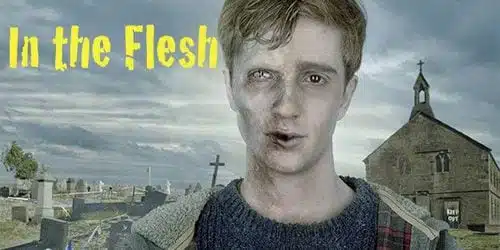
Dead Set. World War Z, Shaun of the Dead, The Walking Dead. Pride and Prejudice and Zombies. I Am Legend. Dead Island. Dawn of the Dead. Warm Bodies. When zombies come, they come not as single spies, but as battalions. There have been so many outbreaks of the undead over recent years that they’ve overrun the pages of fiction to shuffle grimly into the real world.
In 2011, Leicester City Council was obliged to admit that they had no fixed plans in event of a zombie uprising. The Center for Disease Control was a little more prepared. Their advice included a list of essential survival items including food, water and, touchingly, a copy of your birth certificate.
So we may be approaching a cultural saturation point, but at least we’ve started to look on the bright side of a pending zombie invasion. We’ve stopped fleeing and hiding and started to engage with our undead pursuers. Finally, we’re able to ask the question: can the living and the dead coexist?
Naturally, accommodations for the undead have to be found. At the end of Shaun of the Dead, Shaun’s undead buddy Ed, is permitted to continue playing Timesplitters 2 with him but only as long as he remains safely chained up in the garden shed.
If only it were that easy. In The Flesh, a new drama from the BBC, paints a much bleaker picture. Set some years after a zombie outbreak, the show examines life for undead teenager Keiran Walker after a partial ‘cure’ is found and some semblance of a normal life becomes possible. Well, almost possible. On returning to his home village of Roarton, Walker (watch those surnames) discovers that ordinary life, or rather death, is far from likely.
In most zombie fiction, the drama focuses on the living. They’re the ones with characters, with the cares, the loves and the fears. The zombies themselves are usually presented as a threat in the aggregate, an ‘invasion’ or even an ‘infestation’. They are an impersonal menace, as individually nameless as bacteria with a strength lying in numbers and implacability.
In the Flesh toys with this formula. Keiran is ostensibly the hero, staring in mute bewilderment at a world utterly changed, while anti-zombie forces muster around the shared goal of his destruction. The inversion is a clever one, reminding the viewer that both parties are victims, whether living or partially dead.
It also adds a potential for richness in character that has all too often been missing from the genre. Unfortunately, it’s an opportunity squandered. Too many of the characters feel flat or simplistic. Their motivations are either clichéd or too thin. Discovering that some of the most vehement anti-zombie activists have secrets they’d prefer to keep literally buried is far too obvious, while seeing dazed suburbanites kit themselves out with ready-prepared, albeit rudimentary, weapons is jarring. The three-episode running time may bear some of the responsibility; there simply isn’t the time to develop the responses of the characters.
The show’s brevity is even more punishing of the writer’s ideas, but only because they are so numerous. The script is positively swarming with good ideas, so much so that three episodes simply will not be sufficient to do them all justice.
The government has mandated that zombies, sorry, Partially Diseased Syndrome (PDS) sufferers (the terminology is important) will be given treatment and returned to their homes. The question is, why? Aside from the general democratic requirement that the state does no harm to its citizens, there appears to be, on the evidence of Roarton anyway, overwhelming public demand for an alternative solution. The agents of the state are eager to absolve the formerly dead from any ‘crimes’ they may have committed while under the influence of being wormfood, but again, why? It certainly does not look like an affordable, or risk-free, solution.
A private corporation appears to be involved, the reassuringly bland-sounding Halperin & Weston, but what’s its angle? Is there any money in rehumanising zombies? There’s certainly money to be made in illness, and it’s as a metaphor for illness that the show has the most fun. It’s at its strongest when it portrays the zombies as a public health issue.
The insistent terminology from the clinically euphemistic PDS to the aggressively demotic ‘rotters’, gives great fun at examining the gap between official position and public attitudes to conditions with a socially damaging element. It’s perfectly safe, says the man from the government, but it doesn’t look safe, reply the angry townsfolk, it doesn’t feel safe.
If the official message fails to reach home, it’s hardly surprising. The strength of feeling against PDS is many magnitudes greater than feelings of support. Returning home, Keiran is forced to hide underneath a coat in the back of his dad’s Volvo, while the villagers, a lethal combination of the pious and the paramilitary, gather outside, hinting darkly of their displeasure of the parents’ recusancy. They, the Walkers, are acting within the law, but they are forced to behave like rebels, while the opposition hold every seat of local power.
Although the zombies themselves have their own emergent culture, with their own political aims and even their own recreational drugs, it’s a counter-culture. They remain outsiders, unwanted by the population at large and insufficiently protected by the state. The parallels are obvious.
The setting itself is ideal. Roarton is one of those countless identikit villages that proliferate in the north of England. It’s quiet and unassuming but dangerous in its isolation and near-empty in the aftermath of the outbreak. Crucially for the plot, everybody knows everybody else’s business. How can you disguise the fact that your newly-returned loved one is dead when the people wielding the pitchforks attended her funeral? It provides an excellent testing ground not only for the fictional government but also for the drama. Hiding places are few and a formerly close-knit community seems the last place to offer peaceful coexistence.

